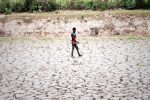Sep 23, 2019
New York: World’s leading climate science organizations have joined forces to produce a landmark new report for the UN Climate Action Summit, underlining the glaring and growing gap between agreed targets to tackle global warming and the actual reality.
The report — United in Science — released on Sunday includes details on the state of the climate and presents trends in the emissions and atmospheric concentrations of the main greenhouse gases.
It highlights the urgency of fundamental socio-economic transformation in key sectors such as land use and energy in order to avert dangerous global temperature increase with potentially irreversible impacts.
It also examines tools to support both mitigation and adaptation.
“The report provides a unified assessment of the state of our earth system under the increasing influence of anthropogenic climate change, of humanity’s response thus far and of the far-reaching changes that science projects for our global climate in the future. The scientific data and findings presented in the report represent the very latest authoritative information on these topics,” said the Science Advisory Group to the UN Secretary-General’s Climate Action Summit.
“It highlights the urgent need for the development of concrete actions that halt global warming and the worst effects of climate change.”
The Science Advisory Group is co-chaired by WMO Secretary-General Petteri Taalas and former Vice Chancellor of TERI School of Advanced Studies, Leena Srivastava.
It comprises highly recognised and respected natural and social scientists, with expertise in different aspects of climate change, including on mitigation and adaptation.
The report, which was coordinated by the World Meteorological Organization (WMO), aims to present a “transparent envelope” of authoritative and actionable cutting-edge science.
The synthesis report consists of short summaries from contributing agencies: the WMO, Global Atmosphere Watch, the United Nations Environment Programme, Global Carbon Project, the Intergovernmental Panel on Climate Change (IPCC), Future Earth, Earth League and the Global Framework for Climate Services.
The synthesis is complemented by longer, individual reports, presented as a package to a high-level science event on September 22 and then to world leaders at the Climate Action Summit on September 23.
Highlights from the report include the global climate in 2015-2019.
The average global temperature for 2015-2019 is on track to be the warmest of any equivalent period on record.
It is currently estimated to be 1.1 degrees Celsius (A 0.1 degrees) above pre-industrial (1850-1900) times.
Widespread and long-lasting heatwaves, record-breaking fires and other devastating events such as tropical cyclones, floods and drought have had major impacts on socio-economic development and the environment.
Continued decrease of sea ice and ice mass.
Arctic summer sea-ice extent has declined at a rate of approximately 12 per cent per decade during 1979-2018.
The four lowest values for winter sea-ice extent occurred between 2015 and 2019.
Overall, the amount of ice lost annually from the Antarctic ice sheet increased at least six-fold between 1979 and 2017.
Glacier mass loss for 2015-2019 is the highest for any five-year period on record.
The other highlight of the report is sea-level rise is accelerating and sea water is becoming more acidic.
The observed rate of global mean sea-level rise accelerated from 3.04 mm per year (mm/yr) during the period 1997-2006 to approximately 4mm/yr during the period 2007-2016.
This is due to the increased rate of ocean warming and melting of the Greenland and West Antarctica ice sheets.
There has been an overall increase of 26 per cent in ocean acidity since the beginning of the industrial era.
There is a record greenhouse gas concentrations in the atmosphere.
Levels of the main long-lived greenhouse gases, carbon dioxide (CO2), methane (CH4)) and nitrous oxide (N2O) have reached new highs.
The last time earth’s atmosphere contained 400 parts per million CO2 was about 3-5 million years ago, when global mean surface temperatures were 2-3 degrees Celsius warmer than today, ice sheets in Greenland and West Antarctica melted, parts of East Antarctica ice had retreated, all causing global see level rise of 10-20m compared with today.
In 2018, global CO2 concentration was 407.8 parts per million (ppm), 2.2 ppm higher than 2017.
Preliminary data from a subset of greenhouse gas monitoring sites for 2019 indicate that CO2 concentrations are on track to reach or even exceed 410 ppm by the end of 2019. IANS



















